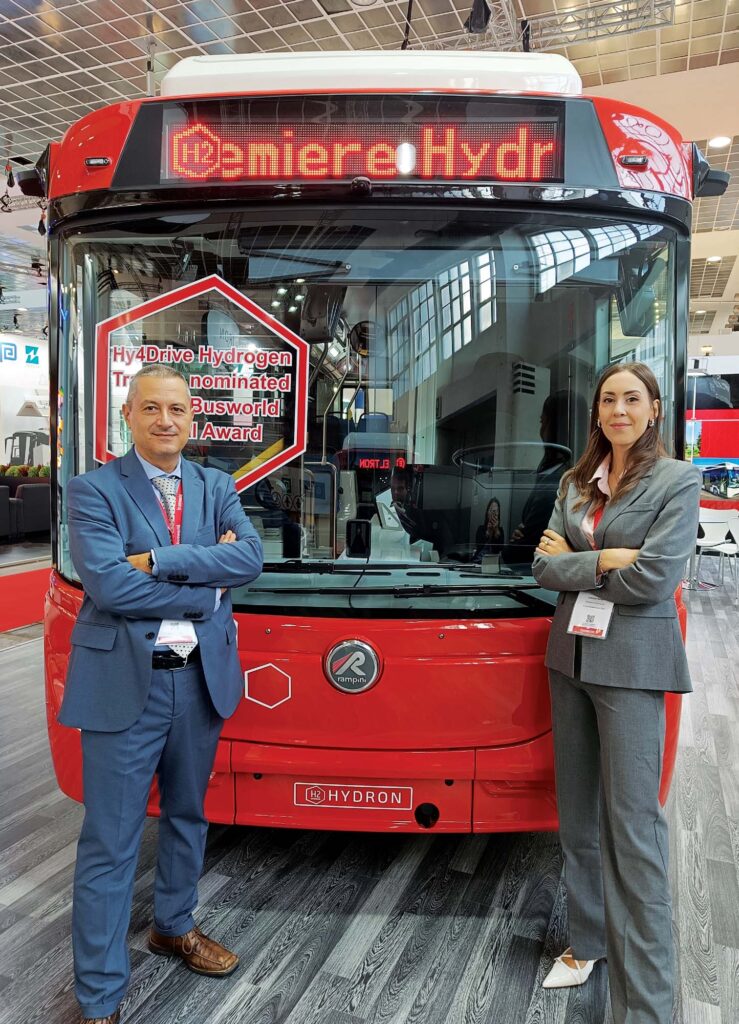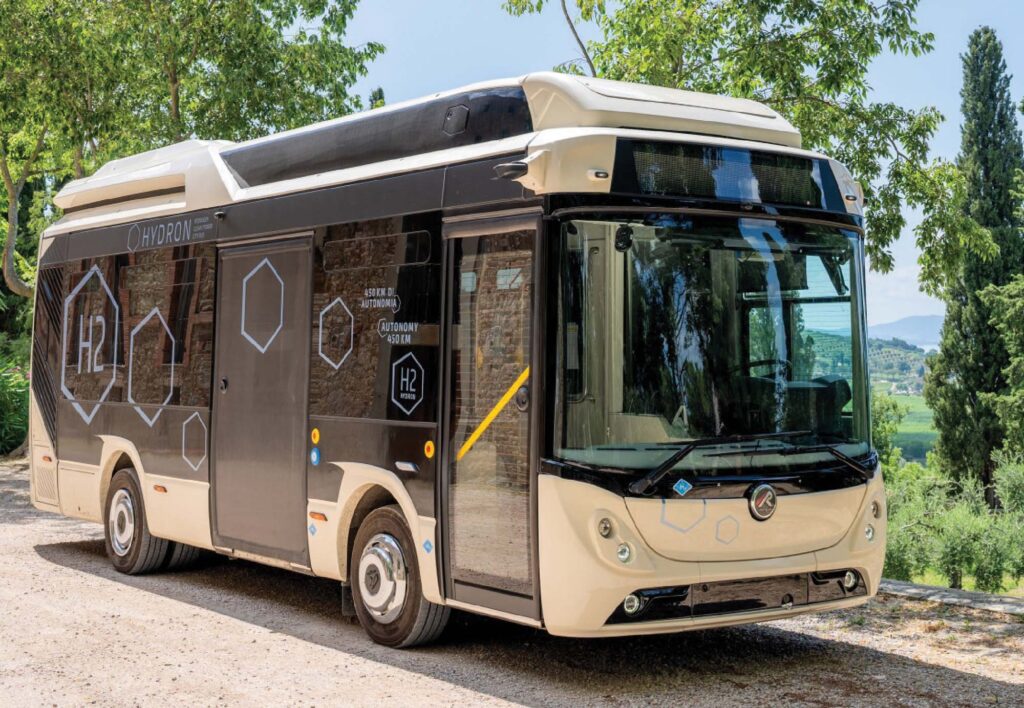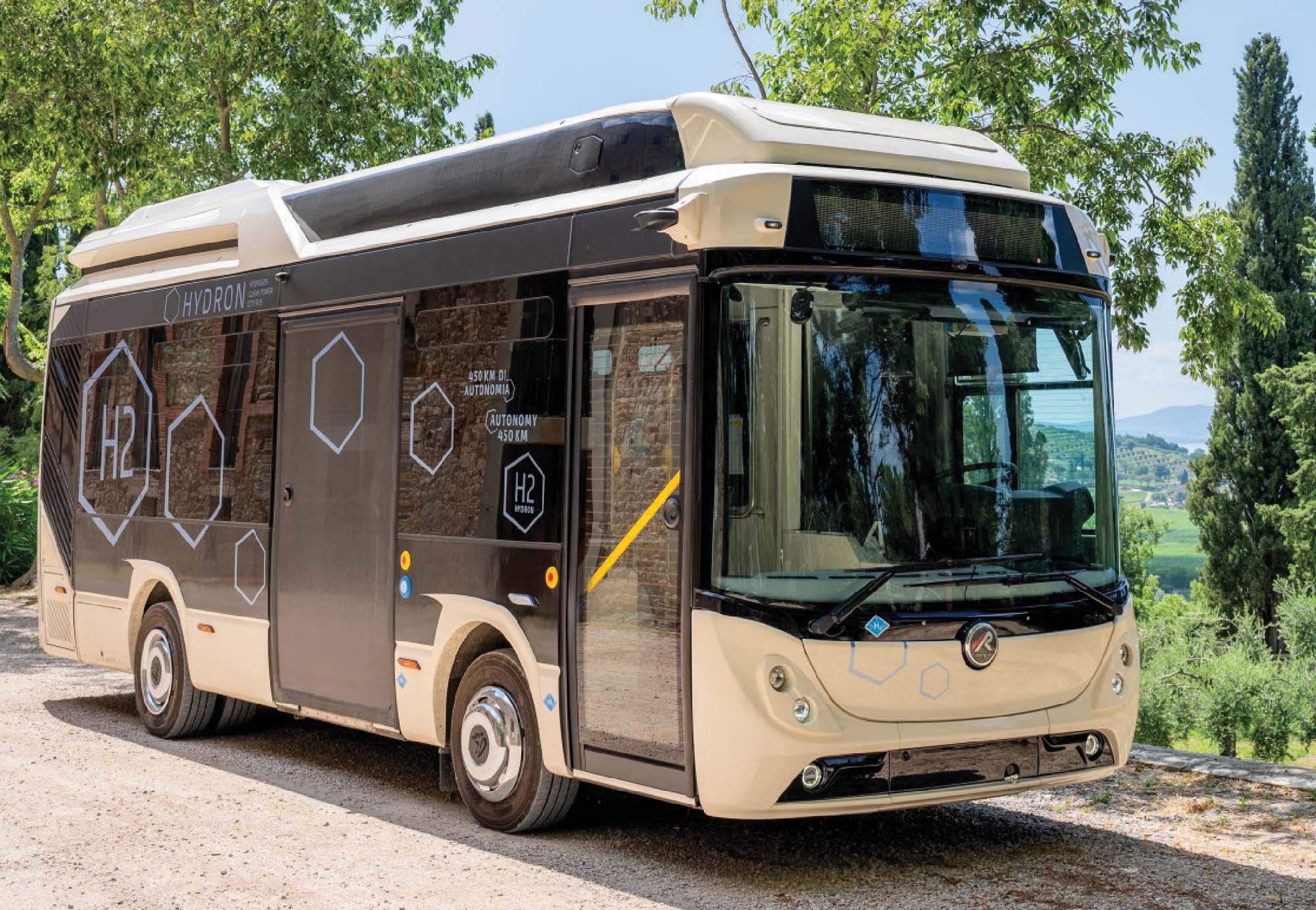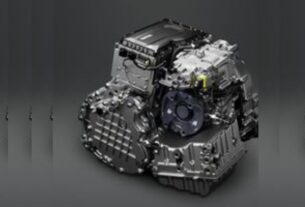
The medium-sized Italian bus builder RAMPINI spa in Passignano sul Trasimeno (IT) participates for the first time in its history in Busworld Europe in Brussels and shows its full portfolio of Zero Emission buses in a compact size. The highlight will be the presentation of the new Hydrogen Range Extender Midibus HYDRON, that goes into production in 2024. Also the electric version of the eight meter Midibus ELTRON is featured with a new Design called “Stile Energetico”, made by the prestigious Italian Design Studio Vernacchia. Last but not least the smallest family member with six meters length joins the show: the SIXTRON for up to 28 passengers – also fully electric.
80 years of Automotive Craftsmanship
Founded in 1945, the company, which has today a great industrial tradition, started off with the maintenance and development of common and special vehicles. During the time other fields of expertise like industrial machinery and process competences extended the portfolio of the company, which has grown quickly in turnover and size. Today Hi-Tech equipment like Iron Rollers for the famous “Pistenbullis” preparing skiing areas in the alps are produced from RAMPINI as well as diverse equipment like Energy Stations and other Hi-Tech special equipments for the defense sector. The industrial portfolio is therefore very diversified.
RAMPINI has been committed to the theme of decarbonisation of municipal transport and waste disposal as well as the electrification of commercial vehicles since the early 2000s. Since then, around 200 electric buses have left the factory halls in Passignano and have been delivered to six European countries – Germany, France, Austria, Spain and Greece in addition to Italy. In May 2023, the company won part of the large Consip tender one of the company’s biggest sales successes to date. Since 2022, the next generation of the family has joined the management: Caterina Rampini as CEO and Vice President, and Andrea Rampini as CEO and R&D Manager. This also marks the beginning of a new era for the company, which employs around 100 people.

World Premiere: Hydrogen Midibus HYDRON
Sometimes it appears in the bus and coach industry, that there is the salient question of “Battery versus Hydrogen” as a means of energy-storage and provision. But in fact it is not the question to say A or B, but sometimes both! RAMPINI is therefore the first manufacturer to offer a compact Midibus with a well-sized battery and a hydrogen range extender to combine the best of both worlds. Basically, every hydrogen bus is a electric bus – the defining question is just, how big are battery and fuel cell and their relevance for the Traction System. This is also the reason, why the models ELTRON (see below) and HYDRON are not completely different models, but rather “two sides of the green Zero Emission Coin”, with most parts and concepts shared among each other: body concept, Stile Energetico- Design, Driveline, Interior design etc. The advantage for the customer: no complex spare parts handling, when both models should be in the fleet. Out of conceptual reasons, the HYDRON is offered only in a two-door-version unlike the ELTRON, which is also available with three doors.
The concept is easy: the somewhat smaller sized battery pack (175 kWh net instead of 270 kWh) is supported by a compact 30 kW fuel cell by the Canadian manufacturer Loop Energy. Due to the innovative eFlowTM architecture of the company, the fuel cells offer a 16 percent lower consumption of precious hydrogen while at the same time boasting up to 90 percent higher peak power and ten times better current density uniformity with the same stack size. The superfluous heat of the fuel cell as well as the traction is harvested efficiently and supports the heating for the drivers or even the passengers area.
The fuel cell is managed by the RAMPINI own “Hy4Drive”-System, which is explained below in detail. The fuel cell has a very conservatively estimated, 10.000 hours lifespan and so matches the intermittent usage of the cell. It has a preheating for winter, and can be started even in very cold weather after a short waiting time. The three Luxfer Type 3 flasks with 350 bar pressure hold ca. 15 kg of hydrogen in a modular frame, that is also interchangeable with the ELTRON roof installations. With this amount of Grade D Hydrogen, the HYDRON is able to extend its range to more than 400 kilometers in E-SORT 1 and almost over 500 kilometers in E-SORT 2 without heating or A/C. With Hydrogen alone the range can reach also 250 kilometers, what should be enough for a days service in most cases. Due to a partnership with the Italian gas supplier Sappio, RAMPINI is also able to support customers in the setup of their own hydrogen fuel station. The manufacturer has installed such a filling station on its factory premises in Passignano himself recently.
The “Hy4Drive”-System is a electronic Drive Management System for the Hydrogen Bus HYDRON, completely developed in-house by the technicians of RAMPINI. Basically the vehicle functions like a Battery Electric Vehicle (BEV) with a 170 kWh LFP-battery (the mostly identical designed ELTRON offers a 210 resp. 281 kWh battery), but it is coupled with a 30 kW fuel cell. In order to accomplish the most flexible and most efficient way to integrate the fuel cell into the Drive System, the “Hy4Drive-System” offers four different modes of usage of the fuel cell and thus of the whole Drive System. The modes can be individually chosen by the driver in the vehicle System or the systems choses them automatically in case of a malfunction or of low battery energy. Generally, the fuel cell can be activated only under 90 percent E-SOC and runs with low power between 90 and 93 percent E-SOC.
The four modes of Hy4Drive are defined as such:
Range Extender: Designed to maximize daily mileage using energy normally in proportion 40 percent battery and 60 percent Hydrogen energy, which equals the proportion of total on-board energy. Also is it possible to activate a “Pulse-Mode” of the fuel cell with given time slots, when it working or not. This is the ideal mode of driving to reach the best possible range, using battery as well as fuel cell Energy. The fuel cell alone can fill the battery up to 80 percent E-SOC (Electric State of Charge) in about 4 hours and 40 minutes, compared to 7 hours with a 22 kW external charger. In case of high power demand or when the E-SOC falls below 20 percent, the fuel cell is set into a boost mode to deliver maximum power. Thus the Range of the HYDRON is minimum 100 km higher than that of the BEV ELTRON in E-Sort 1.
Pure Hydrogen: In this mode all energy comes from the stored Hydrogen (stored gaseous at 350 bar pressure). The LFP-batteries have only a peek shaving function during acceleration and also a buffer function for storing regenerative braking (recuperation). State of Charge of Battery (E-SOC) is always kept around 90 percent and the fuel cell power can be manually adjusted between 50 and 100 percent. This mode is ideal, if the vehicle is supposed to run on the Batteries in the next service cycle.
Pure Electric: In this Mode all energy comes from the 170 kWh-Traction battery only. The fuel cell is kept always offline and the vehicle is operated like a normal BEV. This mode is ideal, when the Hydrogen storage is empty or other reasons are there, not to fill up the Hydrogen tanks. Also in winter this mode is ideal, as the emitted water of the fuel cell could freeze on the street or in a bus stop, where the vehicle is idling for some time.
Hybrid Custom: In this mode it is possible to customize exactly how much energy is drawn from the 170 kWh Traction-battery respectively from the 30 kW-fuel cell to allow adapting the usage according to the actual depot- and infrastructure-capability. In this way the service and range of the HYDRON can be adjusted tailormade to the daily service needs. This is the most sophisticated mode of the System and needs some skills and close consideration of the depot management.





